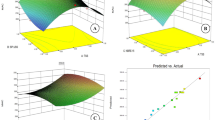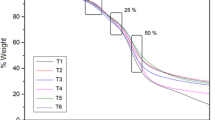Abstract
In this research, saffron petal anthocyanin extract was encapsulated using wall matrices consisting of sodium alginate (SA), maltodextrin (MD), and combination of sodium alginate and maltodextrin (SA:MD) at various ratios by freeze-drying method. The microcapsules were characterized in relation to moisture content, water activity, hygroscopicity, particle size, color, and encapsulation efficiency. Results showed moisture content ranged from 2.14 to 4.01%, aw 0.23 to 0.58, hygroscopicity 10.31 to 21.12%, and particle size 188.53 to 304.30 µm, respectively. Among wall matrices, SA:MD encapsulates exhibited highest encapsulation efficiency 80.10%, anthocyanin stability 153 mg/g, and lowest ΔΕ value after 35-day storage. All the wall matrices increased the half-life of encapsulated microcapsules compared to non-encapsulated during storage. Morphological analysis showed microcapsules were smooth, uniform, and displayed little agglomeration and surface dents. The in vitro gastric conditions showed that microcapsules exhibited high anthocyanin retention than free extracts. To conclude, freeze drying could be recommended as a suitable encapsulation method for stabilizing the saffron petal anthocyanin extract.
Graphical Abstract






Similar content being viewed by others
Data availability
Data is available at request.
References
Kumar A, Devi M, Kumar R, Kumar S (2022) Introduction of high-value Crocus sativus (safron) cultivation in non-traditional regions of India through ecological modelling. Sci Rep 12:11925
Sánchez-Vioque R, Rodríguez-Conde MF, Reina-Ureña JV, Escolano-Tercero MA, Herraiz-Peñalver D, Santana-Méridas O (2012) In vitro antioxidant and metal chelating properties of corm, tepal and leaf from saffron (Crocus sativus L.). Ind Crops Prod 39:149–153
Hemmati KA (2001) Optimization of effective parameters on production of food color from saffron petals. Agric Sci Technol 13(2):21–28
Nørbæk R, Brandt K, Nielsen JK, Ergaard M, Jacobsen N (2002) Flower pigment composition of Crocus species and cultivars used for a chemotaxonomic investigation. Biochem Syst Ecol 30(8):763–791
Khazaei KM, Jafari SM, Ghorbani M, Kakhki AH, Sarfarazi M (2015) Optimization of anthocyanin extraction from saffron petals with response surface methodology. Food Anal Methods. https://doi.org/10.1007/s12161-015-0375-
Andersen OM, Jordheim M (2010) Chemistry of flavonoid-based colors in plants. In: Comprehensive natural products II chemistry and biology, 1st edn. Elsevier, Oxford, pp 547–614
Patras A, Brunton NP, O’Donnell C, Tiwari BK (2010) Effect of thermal processing on anthocyanin stability in foods; mechanisms and kinetics of degradation. Trends Food Sci Technol 21(1):3–11
Akhavan Mahdavi S, Jafari SM, Ghorbani M, Assadpour E (2014) Spray drying microenapulation of anthocynianin by natural biopolymers: a review. Drying Technol 32(5):509–518
Leong JY, Lam WH, Ho KW, Voo WP, Lee MFX, Lim HP (2016) Advances in fabricating spherical alginate hydrogels with controlled particle designs by ionotropic gelation as encapsulation systems. Particuology 24:44–60
Bakowska-Barczak AM, Kolodziejczyk PP (2011) Black currant polyphenols: their storage stability and microencapsulation. Ind Crops Prod 34:1301–1309
Silva GJFD, Constant PBL, Figueiredo RWD, Moura SM (2010) Formulation and stability of anthocyanins’s colorants formulated with peels jabuticaba (Myrciaria ssp.). Alimentos e Nutriçao 21:429–436
Hu Y, Kou G, Chen Q, Li Y, Zhou Z (2019) Protection and delivery of mandarin (Citrus reticulata Blanco) peel extracts by encapsulation of whey protein concentrate nanoparticles. LWT Food Sci Tech 99:24–33
Hu Y, Li Y, Zhang W, Kou G, Zhou Z (2018) Physical stability and antioxidant activity of citrus flavonoids in Arabic gum-stabilized microcapsules: modulation of whey protein concentrate. Food Hydrocoll 77:588–597
Popovic BM, Blagojevic B, Latkovic D, Cetojevic-Simin D, Kucharska AZ, Parisi F et al (2021) A one step enhanced extraction and encapsulation system of cornelian cherry (Cornus mas L) polyphenols and iridoids with β-cyclodextrin. LWT 141:110884
AOAC (2006) Official methods of analysis. AOAC Press, Philadelphia, USA
Lee J, Durst RW (2005) Determination of total monomeric anthocyanin pigment content of fruit juices, beverages, natural colorants, and wines by the pH differential method: collaborative study. J AOAC Int 88(5):1269–1278
AOAC (2000) Official methods of analysis. Association of official analytical chemists, 17th edn, vol II. Washington, DC
Cano-Chauca M, Stringheta PC, Ramos AM, Cal-Vidal J (2005) Effect of the carriers on the microstructure of mango powder obtained by spray drying and its functional characterization. Innov Food Sci Emerg Technol 6(4):420–428
Fang Z, Bhandari B (2011) Effect of spray drying and storage on the stability of bayberry polyphenols. Food Chem 129(3):1139–1147
Sakulnarmrat K, Konczak I (2022) Encapsulation of Melodorum fruticosum Lour. Anthocyanin rich extract and its incorporation into model food. LWT Food Sci Technol 153:112546
AOAC (2005) Official methods of analysis. Association of official analytical chemists, 14th edn, vol II. Washington, DC
Brand-Williams W, Cuvelier ME, Berset C (1995) Use of free radical method to evaluate antioxidant activity. LWT- Food Sci Technol 28:25–30
Gani A, Shah A, Ahmad M, Ashwar BA, Masoodi FA (2018) β-d-glucan as an enteric delivery vehicle for probiotics. Int J Biol Macromol. https://doi.org/10.1016/j.ijbiomac.2017.08.093
Ahmadian-Kouchaksaraie Z, Niazmand R, Najafi MN (2016) Optimization of the subcritical water extraction of phenolic antioxidants from Crocus sativus petals of saffron industry residues: Box-Behnken design and principal component analysis. Innov Food Sci Emerg Technol 36:234–244
Jafari SM, Mahdavi-Khazaei K, Hemmati-Kakhki A (2016) Microencapsulation of saffron petal anthocyanins with cress seed gum compared with Arabic gum through freeze drying. Carbohydr Polym 140:20–25
Gauche C, Malagoli ES, Luiz MTB (2010) Effect of pH on the copigmentation of anthocyanins from Cabernet Sauvignon grape extracts with organic acids. Sci Agric 67(1):41–46
Yamashita C, Chung MMS, Santos CD, Mayer CRM, Moraes ICF, Branco IG (2017) Microencapsulation of an anthocyanin-rich blackberry (Rubus spp.) by-product extract by freeze-drying. LWT - Food Sci Technol 84:256–262
Tonon RV, Brabet C, Hubinger MD (2010) Anthocyanin stability and antioxidant activity of spray-dried açai (Euterpe oleracea Mart.) juice produced with different carrier agents. Food Res Int 43(3):907–914
Quek SY, Chok NK, Swedlund P (2007) The physicochemical properties of spray-dried watermelon powders. Chem Eng Process: Process Intensif 46:386–392
Baeza R, Sánchez V, Salierno G, Molinari F, López P, Chirife J (2020) Storage stability of anthocyanins in freeze-dried elderberry pulp using low proportions of encapsulating agents. Food Sci Technol Int 27:135–144
Rocha-Parra DF, Lanari MC, Zamora MC, Chirife J (2016) Influence of storage conditions on phenolic compounds stability, antioxidant capacity and colour of freeze-dried encapsulated red wine. LWT-Food Sci Technol 70:162–170
Caliskan G, Dirim SN (2016) The effect of different drying processes and the amounts of maltodextrin addition on the powder properties of sumac extract powders. Powder Technol 287:308–314
Todorovic A, Sturm L, Salevic-Jelic A, Levic S, Crnivec IGO, Prislan I, Skrt M, Bjekovic V, Ulrih NP, Nedovic V (2022) Encapsulation of bilberry extract with maltodextrin and gum Arabic by freeze-drying: formulation, characterisation and storage stability. Processes 10:1–16
Mishra P, Mishra S, Mahanta CL (2014) Effect of maltodextrin concentration and inlet temperature during spray drying on physicochemical and antioxidant properties of amla (Emblica officinalis) juice powder. Food Bioprod Process 92:252–258
Mahdavi SA, Jafari SM, Assadpoor E, Dehnad D (2016) Microencapsulation optimization of natural anthocyanins with maltodextrin, gum Arabic and gelatin. Int J Biol Macromol 85:379–385
Tonon RV, Brabet C, Hubinger MD (2008) Influence of process conditions on the physicochemical properties of acai (Euterpe oleraceae Mart.) powder produced by spray drying. J Food Eng 88:411–418
Cabuk M, Yavuz M, Unal HI (2016) Electrokinetic, electrorheological and viscoelastic properties of polythiophene- graft-chitosan copolymer particles. Colloids Surf A Physicochem Eng Asp 510:231–238
Enache LM, Vasile MA, Crăciunescu O, Prelipcean AM, Oancea A, Enachi E, Vasilica Barbu VV, Stănciuc N, Vizireanu C (2022) Co-microencapsulation of anthocyanins from cornelian cherry (Cornus mas L.) fruits and lactic acid bacteria into antioxidant and anti-proliferative derivative powders. Nutrients 14:34–58
Oanceaa AM, Hasanb M, Vasilea AM, Barbua V, Enachia E, Bahrima G, Râpeanua G, Silvib S, Stănciuc N (2018) Functional evaluation of microencapsulated anthocyanins from sour cherries skins extract in whey proteins isolate. LWT-Food Sci Technol 95:129–134
Sakulnarmrat K, Wongsrikaew D, Konczak I (2021) Microencapsulation of red cabbage anthocyanin-rich extract by drum drying technique. LWT-Food Sci Technol 137:110473
Idham Z, Muhamad II, Sarmidi MR (2012) Degradation kinetics and color stability of spray-dried encapsulated anthocyanins from Hibiscus Sabdariffa L. J Food Process Eng 35(4):522–542
Azarpazhooh E, Sharayei P, Zomorodi S, Ramaswamy HS (2109) Physicochemical and phytochemical characterization and storage stability of freeze-dried encapsulated pomegranate peel anthocyanin and in-vitro evaluation of its antioxidant activity. Food and Bioprocess Technol 12:199–210
Jafari SM, Assadpoor E, He Y, Bhandari B (2008) Encapsulation efficiency of food flavours and oils during spray drying. Drying Technol 26(7):816–835
Nayak CA, Rastogi NK (2010) Effect of selected additives on microencapsulation of anthocyanin by spray drying. Drying Technol 28:1396–1404
Jimenez-Aguilar D, Ortega-Regules A, Lozada-Ramïrez J, Pierez-Peirez M, Vernon-Carter E, Welti-Chanes J (2011) Color and chemical stability of spray-dried blueberry extract using mesquite gum as wall material. J Food Compos Anal 24(6):889–894
Maskan M (2006) Production of pomegranate (Punica granatum L.) juice concentrate by various heating methods: colour degradation and kinetics. J Food Eng 72(3):218–224
Jang Y, Koh E (2023) Characterisation and storage stability of Aronia anthocyanins encapsulated with combinations of maltodextrin with carboxymethyl cellulose, gum Arabic and xanthan gum. Food Chem 405:135002
Pieczykolan E, Kurek MA (2019) Use of guar gum, gum Arabic, pectin, beta-glucan and inulin for microencapsulation of anthocyanins from chokeberry. Int J Biol Macromol 129:665–671
Man B, Irwandi J, Abdullah WJW (1999) Effect of different types of maltodextrin and drying methods on physico-chemical and sensory properties of encapsulated durian flavour. J Sci Food Agri 79:1075–1080
Pereira VA, de Arruda INQ, Stefani R (2015) Active chitosan/PVA films with anthocyanins from Brassica oleraceae (red cabbage) as time-temperature indicators for application in intelligent food packaging. Food Hydrocoll 43:180–188
Rosa JRD, Nunes GL, Motta MH, Fortes JP, Weis GCC, Hecktheuer LHR, Muller EI, Menezes CRD, Rosa CSD (2019) Microencapsulation of anthocyanin compounds extracted from blueberry (Vaccinium spp.) by spray drying: characterization, stability and simulated gastrointestinal conditions. Food Hydrocoll 89:742–748
David L, Danciu V, Moldovan B, Filip A (2019) Effects of in-vitro gastrointestinal digestion on the antioxidant capacity and anthocyanin content of cornelian cherry fruit extract. Antioxid. https://doi.org/10.3390/antiox8050114
Zhang R, Zhou L, Li J, Oliveira H, Yang N, Jin W, Zhu Z, Li S, He J (2020) Microencapsulation of anthocyanins extracted from grape skin by emulsification/ internal gelation followed by spray/freeze-drying techniques: characterization, stability and bioaccessibility. LWT - Food Sci Technol 123:109097
Sengul H, Surek E, Nilufer-Erdil D (2014) Investigating the effects of food matrix and food components on bioaccessibility of pomegranate (Punica granatum) phenolics and anthocyanins using an in-vitro gastrointestinal digestion model. Food Res Int 62:1069–1079
Funding
The first author would like to thank Indian Council of Medical Research (ICMR) for financial support in the form of Post Doc Research Associate Fellowship with Award No. 3/1/2/293/2021/-Nut.
Author information
Authors and Affiliations
Contributions
AG, manuscript original writing, experimentation, and data analysis. FAM, supervision and reviewing. AG, data curation and editing.
Corresponding author
Ethics declarations
Ethical approval.
Not applicable.
Conflict of interest
The authors declare no competing interests.
Additional information
Publisher's Note
Springer Nature remains neutral with regard to jurisdictional claims in published maps and institutional affiliations.
Rights and permissions
Springer Nature or its licensor (e.g. a society or other partner) holds exclusive rights to this article under a publishing agreement with the author(s) or other rightsholder(s); author self-archiving of the accepted manuscript version of this article is solely governed by the terms of such publishing agreement and applicable law.
About this article
Cite this article
Gull, A., Masoodi, F.A. & Gani, A. Valorization of saffron petal waste anthocyanin extract, microencapsulation storage kinetic stability, and in vitro release behavior of anthocyanin microcapsules. Biomass Conv. Bioref. (2024). https://doi.org/10.1007/s13399-024-05599-x
Received:
Revised:
Accepted:
Published:
DOI: https://doi.org/10.1007/s13399-024-05599-x




